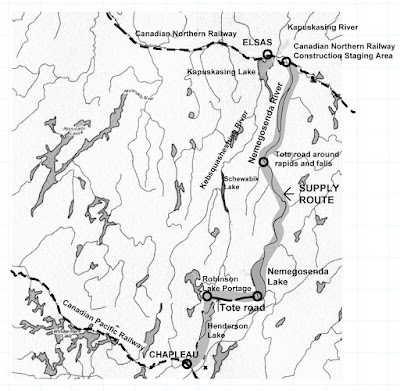 |
| CPR staging area at Rossport (McKay's Harbour) 1884 CP Corp Archives |
by Ian Macdonald and Mike McMullen
The routes of Canada’s major transcontinental railways were largely determined by how easily roadbed construction activity could be supplied with materials and equipment. Sir Sandford Fleming, who was Engineer in Chief for the Canadian Pacific Railway (CPR) in 1877, recommended to the Government at that time that the most favourable conditions for railroad construction through Northern Ontario were north of the height of land.
These recommendations were subsequently rejected by the government in favour of a route for the CPR along the north shore of Lake Superior where construction activity could be more easily supplied with materials and equipment by lakes streamers and sailing vessels to various construction staging points along the north shore of Superior such as Mazokama (Kama), Rossport (McKay’s Harbour), Heron Bay and Michipicoten... see photo above
This was coupled with the decision to construct the roadbed east of Lake Superior along the height of land largely between White River and Cartier. Tracklayers under the direction of Harry Abbot progressed west from Biscotasing to Girdwood which was 39 miles east of White River between October 1884 and April 1885 at an approximate rate of ¾ mile per day. Tracklayers were supplied by work trains following behind which was the standard way of building railways in the roadless world of late 19th century Northern Ontario.
 |
| 2, Trailblazers: CPR tracklayers west of Sudbury (1884) CP Corp Archives |
Eventually, Fleming’s original 1877 recommendations to build north of the height of land were finally adopted by the Canadian Northern Railway (CNoR) when the company began construction of a new 617 mile rail line in 1911 between Capreol and Port Arthur. The line would be located approximately 60 miles north of Chapleau. Speed of construction was of paramount concern for CNoR who rejected the traditional method of roadbed construction used by the CPR in 1884-85 as being too slow. see photo 2 above
It was determined that the only way to meet construction deadline challenges was to haul supplies north from the CPR at a series of construction staging points along the line, which would be stockpiled with supplies and equipment during the winter of 1911-12. These supplies would subsequently support the army of men and horses engaged in the real construction operations beginning in the spring of 1912 which progressed east and west from each construction staging area. Completion of the line was scheduled for January 1, 1914.
 |
| 3. Rail Bridge: CN bridge over Nemegosenda River near Elsas. (1953) ian Macdonald |
In 1962, The Chapleau Sentinel carried an article written by Charles Austin, youngest brother of James McNiece Austin, on the occasion of the 50th anniversary of Smith and Chapple Limited in 1937. Included was a description of the effort to develop the supply network from Chapleau to Elsas for the CNoR work crews. It was led by business partners James McNiece Austin and George Nicholson despite the fact that they were not at that time directly involved in the transportation of retail supplies and materials.
 |
| 4. Description of supply route (2011) Ian Macdonald |
Motor boats were then used to convey supplies from this point north on the Nemegosenda to the construction camps near Elsas. Charles Austin wrote that over 100 teams of horses were worked at one time during the winter months.
An article in a 1965 issue of the Chapleau Sentinel describes how this challenging supply problem was dealt with from an operational point of view. In 1912 and 1913, Edgar Pellow was contracted to haul freight, mail and other supplies to the contractors, James Stewart and Son and Courtney and Conmee, who had contracted to cut the right of ways and lay rails in the vicinity of the present hamlet of Elsas during the spring, summer and fall seasons. Tom Godfrey and Harry Pellow freighted the goods by motor boat and scow from Chapleau to Robinson Lake Portage. (18 mile rapids).
Charlie Leon and Sev Martin hauled the goods over the 11 miles of road from the Chapleau River to Nemegosenda Lake with horse drawn wagons. Bill Newsome then took charge and hauled the freight by boat from the landing on the afore mentioned Lake which was just about opposite where the Nemegosenda River empties into the Lake north to the rapids on the Nemegosenda River where a three mile tote road had been cut around them.
On this tote road, Mr. John Blackburn was in charge, assisted by his son Peter, a well known retired Chapeau railroad conductor. From there, motor boats took the supplies on the last leg of the trip to the construction crews. A stop over place was established with a cookhouse at the end of the eleven mile road on Nemegosenda Lake. This was in charge of Mrs. LaCasse who with her young son and daughter looked after the place during the first year.
The last spike of the Canadian Northern line between Capreol and Port Arthur was driven by CNoR President, Sir William Mackenzie, on January 1, 1914 at Little White Otter River approximately 60 miles north of White River on the CPR.
The concept of supplying and stockpiling supplies from the south proved to be successful for CNoR inasmuch as 617 miles of railroad had been built in less than two years. Sir Sandford Fleming’s early recommendations about the route also proved correct and resulted in the lowest graded railroad on the continent with a grade of four-tenths of one percent with an almost perfect alignment.
See video taken from the cab of an eastbound CN locomotive crossing the steel truss bridge over the Nemegosenda River. https://www.youtube.com/watch?v=kBG9ecEKF68
https://www.youtube.com/watch?v=kBG9ecEKF68
The heavily indebted railway was nationalized by the Canadian Government on September 6, 1918 and eventually merged into the Canadian National Railway System in 1923.



No comments:
Post a Comment